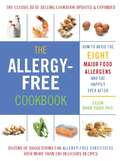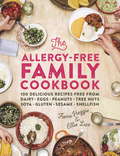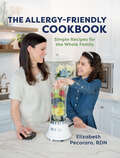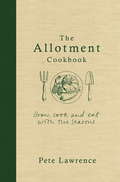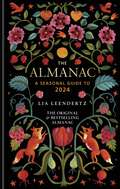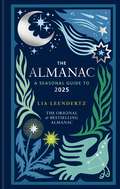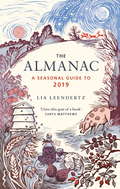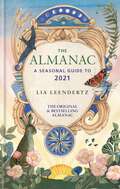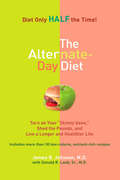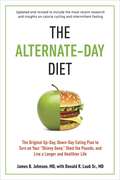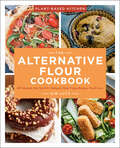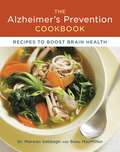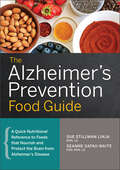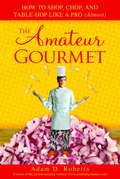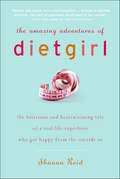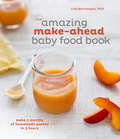- Table View
- List View
The Allergy-Free Cookbook: More than 150 Delicious Recipes for a Happy and Healthy Diet
by Yoder Eileen RhudeFood allergies are on the rise, and the update of this classic cookbook provides more than 180 fantastic recipes to help those with restricted diets With this cookbook, theyOCOll be able to eat well every meal of the day while conquering the most common food allergies. Including more recipes, more tips, more cooking suggestions, more resources, and more information about recently passed laws designed to protect consumers. "
The Allergy-Free Family Cookbook: 100 delicious recipes free from dairy, eggs, peanuts, tree nuts, soya, gluten, sesame and shellfish
by Ellie Lux Fiona HeggieIt's daunting when your child is diagnosed with a food allergy but just because they're allergic to one, or indeed, several types of food doesn't mean that they can't eat delicious meals with the rest of the family, benefit from a healthy, balanced diet or (should they deserve them!) have tasty treats. From shepherd's pie, risottos, Thai curries and casseroles as well as cakes and desserts, The Allergy-Free Family Cookbook is packed full of 100 nutritious recipes, which allow everyone around the table to enjoy the same meal. Using ingredients that can be readily found in supermarkets, each recipe is free from all eight major food allergens: dairy, eggs, peanuts, tree nuts, soya, gluten, sesame and shellfish.
The Allergy-Free Family Cookbook: 100 delicious recipes free from dairy, eggs, peanuts, tree nuts, soya, gluten, sesame and shellfish
by Ellie Lux Fiona HeggieIt's daunting when your child is diagnosed with a food allergy but just because they're allergic to one, or indeed, several types of food doesn't mean that they can't eat delicious meals with the rest of the family, benefit from a healthy, balanced diet or (should they deserve them!) have tasty treats. From shepherd's pie, risottos, Thai curries and casseroles as well as cakes and desserts, The Allergy-Free Family Cookbook is packed full of 100 nutritious recipes, which allow everyone around the table to enjoy the same meal. Using ingredients that can be readily found in supermarkets, each recipe is free from all eight major food allergens: dairy, eggs, peanuts, tree nuts, soya, gluten, sesame and shellfish.
The Allergy-Free Pantry: Make Your Own Staples, Snacks, and More Without Wheat, Gluten, Dairy, Eggs, Soy or Nuts
by Colette Martin&“This book has outstanding solutions for quick meals, on-the-go meals, and ways to make things ahead of time. . . . Kids will love what you make too!&” —San Diego Book Review Make your own affordable, delicious, and allergy-free staples, snacks, and meals! After the cupboards are cleared of problem foods, most people coping with new food allergies (their own or their kids&’) are missing staples they have relied on for years. And even though stores are stocking more allergen-free brands, shoppers with severe or multiple allergies can read every label and still strike out—especially if they&’re after a particular craving or on a budget. The good news for the fifteen million Americans with food allergies is that classic treats and pantry staples can be made easily and affordably at home. From Colette Martin, the author of Learning to Bake Allergen-Free, comes The Allergy-Free Pantry—with over one hundred recipes free of gluten and the top eight allergens (milk, eggs, peanuts, tree nuts, soy, wheat, fish, and shellfish), for: ·Basic staples (flour blends, non-dairy milks, egg replacers, Sandwich Bread, Biscuits, Strawberry Jam, Sunflower Seed Butter) ·Condiments and salad dressings (Flaxseed Mayonnaise, Ketchup, Ranch Dressing, Barbeque Sauce) ·Breakfast (Pancakes, Honey Blueberry Granola, Apple Oatmeal Scones) ·Crackers and cookies (Flax Crackers, Pita Chips, Chocolate Chip Cookies, Snickerdoodles) ·Pasta, pizza, and freezer meals (Spinach Pasta, Cheesy Sauce, Shepherd&’s Pie, Meatloaf) ·Desserts (Brownie Bites, Chocolate Pudding, Raspberry Fruit Roll Ups, Caramel Sauce) Full-color photographs and simple instructions make this a must-have guide to allergy-free home cooking. &“A solid resource for anyone who cooks for people with food allergies.&” —Library Journal
The Allergy-Friendly Cookbook: Simple Recipes for the Whole Family
by Elizabeth PecoraroNo one should feel left out when it comes to healthy eating, regardless of food allergies. In The Allergy-Friendly Cookbook, registered dietitian Elizabeth Pecoraro teaches families with allergies to cook simple, healthy, delicious meals that are completely free of the top nine allergens: peanuts, tree nuts, egg, milk, wheat, soy, fish, shellfish, and sesame. Pecoraro, whose own children live with food allergies, offers 60 allergy-friendly recipes that won't take you hours to prepare and that your whole family will enjoy. With each recipe, she also provides substitution options, nutrition notes, and cooking tips. In addition, she shares which allergy-friendly manufacturers she trusts for her own family. The Allergy-Friendly Cookbook is a must-have resource for families who live with food allergies and want to feed their children healthy, safe meals.
The Allotment Cookbook
by Pete LawrenceTelling the food story of spring, summer, autumn and winter, this is the definitive guide to cooking the right things all through the year. When it comes to the tastiest food, keeping in touch with the rhythm of nature allows us to cook the most delicious recipes with the freshest, most flavoursome ingredients. Each dish is a celebration of the best of local British produce, from Fishcakes with Wilted Chard, Red Pepper and Feta Fritters, Rocket Pesto with Sirloin and Panna cotta with Poached Rhubarb, The Allotment Cookbook follows seasonal produce to restore a natural way of eating. You don't need to have an allotment or big kitchen garden to enjoy this book; although all the ingredients can be found in the shops, have a go at growing your own in the garden, in a scrap of ground or in a pot on a windowsill - it's so easy and is one of life's most satisfying pleasures. The Allotment Cookbook is a joyful guide to a sustainable and nourishing way of life.
The Allotment Cookbook
by Pete LawrenceTelling the food story of spring, summer, autumn and winter, this is the definitive guide to cooking the right things all through the year. When it comes to the tastiest food, keeping in touch with the rhythm of nature allows us to cook the most delicious recipes with the freshest, most flavoursome ingredients. Each dish is a celebration of the best of local British produce, from Fishcakes with Wilted Chard, Red Pepper and Feta Fritters, Rocket Pesto with Sirloin and Panna cotta with Poached Rhubarb, The Allotment Cookbook follows seasonal produce to restore a natural way of eating. You don't need to have an allotment or big kitchen garden to enjoy this book; although all the ingredients can be found in the shops, have a go at growing your own in the garden, in a scrap of ground or in a pot on a windowsill - it's so easy and is one of life's most satisfying pleasures. The Allotment Cookbook is a joyful guide to a sustainable and nourishing way of life.
The Almanac: A Seasonal Guide To 2018 (Almanac)
by Lia LeendertzTHE ORIGINAL & BESTSELLING ALMANACReconnect with the seasons in Britain and Ireland with this month-by-month guide to the world around us - including tide tables, sunrises and moon phases; garden feasts, wildlife and folklore; seasonal recipes, snacks and more.The Almanac: A Seasonal Guide to 2024 gives you the tools and inspiration you need to celebrate, mark and appreciate each month of the year in your own particular way.Divided into the 12 months, a set of tables each month gives it the feel and weight of a traditional almanac, providing practical information that gives access to the outdoors and the seasons, perfect for expeditions, meteor-spotting nights and beach holidays. This year's edition focuses on the natural wonders of the garden, celebrating the beautiful flora and fauna at your doorstep. There are also features on each month's unique nature, plus a flower and a snack of the month.You will find yourself referring to The Almanac all year long, revisiting it again and again, and looking forward to the next edition as the year draws to a close.PRAISE FOR THE ALMANAC:'Lia Leendertz's classic almanac never fails to delight' - The Herald'It's a perfect Christmas present' - Allan Jenkins, The Observer'The perfect companion to the seasons' - India Knight'Indispensable' - Sir Bob Geldof'This book is your bible' - The Independent'I love this gem of a book' - Cerys Matthews
The Almanac: A Seasonal Guide To 2018 (Almanac)
by Lia LeendertzTHE ORIGINAL & BESTSELLING ALMANACReconnect with the seasons in Britain and Ireland with this month-by-month guide to the world around us - including tide tables, sunrises and moon phases; garden feasts, wildlife and folklore; seasonal recipes, snacks and more.The Almanac: A Seasonal Guide to 2024 gives you the tools and inspiration you need to celebrate, mark and appreciate each month of the year in your own particular way.Divided into the 12 months, a set of tables each month gives it the feel and weight of a traditional almanac, providing practical information that gives access to the outdoors and the seasons, perfect for expeditions, meteor-spotting nights and beach holidays. This year's edition focuses on the natural wonders of the garden, celebrating the beautiful flora and fauna at your doorstep. There are also features on each month's unique nature, plus a flower and a snack of the month.You will find yourself referring to The Almanac all year long, revisiting it again and again, and looking forward to the next edition as the year draws to a close.PRAISE FOR THE ALMANAC:'Lia Leendertz's classic almanac never fails to delight' - The Herald'It's a perfect Christmas present' - Allan Jenkins, The Observer'The perfect companion to the seasons' - India Knight'Indispensable' - Sir Bob Geldof'This book is your bible' - The Independent'I love this gem of a book' - Cerys Matthews
The Almanac: A Seasonal Guide To 2018 (Almanac)
by Lia LeendertzThe original and bestselling almanacReconnect with the seasons in Britain and Ireland with this month-by-month guide to the world around us - including tide tables, sunrises and moon phases; wildlife and folklore; seasonal recipes and more.The Almanac: A Seasonal Guide to 2025 gives you the tools and inspiration you need to celebrate, mark and appreciate each month of the year in your own particular way.Divided into the 12 months, a set of tables each month gives it the feel and weight of a traditional almanac, providing practical information that gives access to the outdoors and the seasons, perfect for expeditions, meteor-spotting nights and beach holidays. And it's the ideal gift!You will find yourself referring to The Almanac all year long, revisiting it again and again, and looking forward to the next edition as the year draws to a close.PRAISE FOR THE ALMANAC:'Lia Leendertz's classic almanac never fails to delight' - The Herald'It's a perfect Christmas present' - Allan Jenkins, The Observer'The perfect companion to the seasons' - India Knight'Indispensable' - Sir Bob Geldof'This book is your bible' - The Independent'I love this gem of a book' - Cerys Matthews
The Almanac: A Seasonal Guide To 2018 (Almanac)
by Lia LeendertzThe original and bestselling almanacReconnect with the seasons in Britain and Ireland with this month-by-month guide to the world around us - including tide tables, sunrises and moon phases; wildlife and folklore; seasonal recipes and more.The Almanac: A Seasonal Guide to 2025 gives you the tools and inspiration you need to celebrate, mark and appreciate each month of the year in your own particular way.Divided into the 12 months, a set of tables each month gives it the feel and weight of a traditional almanac, providing practical information that gives access to the outdoors and the seasons, perfect for expeditions, meteor-spotting nights and beach holidays. And it's the ideal gift!You will find yourself referring to The Almanac all year long, revisiting it again and again, and looking forward to the next edition as the year draws to a close.PRAISE FOR THE ALMANAC:'Lia Leendertz's classic almanac never fails to delight' - The Herald'It's a perfect Christmas present' - Allan Jenkins, The Observer'The perfect companion to the seasons' - India Knight'Indispensable' - Sir Bob Geldof'This book is your bible' - The Independent'I love this gem of a book' - Cerys Matthews
The Almanac: A Seasonal Guide to 2019
by Lia LeendertzTHE ORIGINAL & BESTSELLING ALMANAC 'I love this gem of a book' - Cerys Matthews 'This book is your bible' - The Independent '...it already feels like an annual necessity' - India Knight'Joyous' - Allan Jenkins'Updated for 2019 with more lovely ideas to celebrate the seasons' - Gardens Illustrated'A charming book. This is a real gem of a gift' - Sunday Express, S Magazine. A perfect toolkit connecting with the world around us and the year ahead as it unfolds - all in a compact and pocket size that just begs you to pick it up and browse - Reckless Gardener or Its range of information and depth of understanding of our seasons is priceless - Reckless GardenerThe Almanac: A Seasonal Guide to 2019 reinvents the tradition of the rural almanac for a new audience. It gives you the tools and inspiration you need to celebrate, mark and appreciate each month of the year in your own particular way. Divided into the 12 months, a set of tables each month gives it the feel and weight of a traditional almanac, providing practical information that gives access to the outdoors and the seasons, perfect for expeditions, meteor-spotting nights and beach holidays. There are also features on each month's unique nature, such as the meteor shower of the month, beehive behaviour, folklore and stories, seasonal recipes and charts tracking moon phases and tides. Why not try identifying trees by their bare buds in January; Enjoy Buttermilk scones with orangle blossom & honey butter in June; Discover the Chinese New Year story of 'The great race' in February.You will find yourself referring to the almanac all year long, revisiting it again and again, and looking forward to the next edition as the year draws to a close.Praise for The Almanac: A Seasonal Guide to 2018:'The perfect companion to the seasons' - India Knight'A richly layered book of events, celebrations and everyday information that together create a beautiful, fascinating resource . . . In the single month I've had my hands on it, the book has quietly "worked".' - Telegraph'Beautifully written, this pocket-sized guide is a labour of love and will remind you to appreciate little moments throughout the year.' - Gardens Illustrated'Elegant . . . an ideal stocking filler.' - The English Garden
The Almanac: A Seasonal Guide to 2019
by Lia LeendertzTHE ORIGINAL & BESTSELLING ALMANAC 'I love this gem of a book' - Cerys Matthews 'This book is your bible' - The Independent '...it already feels like an annual necessity' - India Knight'Joyous' - Allan Jenkins'Updated for 2019 with more lovely ideas to celebrate the seasons' - Gardens Illustrated'A charming book. This is a real gem of a gift' - Sunday Express, S Magazine. A perfect toolkit connecting with the world around us and the year ahead as it unfolds - all in a compact and pocket size that just begs you to pick it up and browse - Reckless Gardener or Its range of information and depth of understanding of our seasons is priceless - Reckless GardenerThe Almanac: A Seasonal Guide to 2019 reinvents the tradition of the rural almanac for a new audience. It gives you the tools and inspiration you need to celebrate, mark and appreciate each month of the year in your own particular way. Divided into the 12 months, a set of tables each month gives it the feel and weight of a traditional almanac, providing practical information that gives access to the outdoors and the seasons, perfect for expeditions, meteor-spotting nights and beach holidays. There are also features on each month's unique nature, such as the meteor shower of the month, beehive behaviour, folklore and stories, seasonal recipes and charts tracking moon phases and tides. Why not try identifying trees by their bare buds in January; Enjoy Buttermilk scones with orangle blossom & honey butter in June; Discover the Chinese New Year story of 'The great race' in February.You will find yourself referring to the almanac all year long, revisiting it again and again, and looking forward to the next edition as the year draws to a close.Praise for The Almanac: A Seasonal Guide to 2018:'The perfect companion to the seasons' - India Knight'A richly layered book of events, celebrations and everyday information that together create a beautiful, fascinating resource . . . In the single month I've had my hands on it, the book has quietly "worked".' - Telegraph'Beautifully written, this pocket-sized guide is a labour of love and will remind you to appreciate little moments throughout the year.' - Gardens Illustrated'Elegant . . . an ideal stocking filler.' - The English Garden
The Almanac: A Seasonal Guide to 2021
by Lia Leendertz'The perfect companion to the seasons' - India KnightWelcome to The Almanac: A Seasonal Guide to 2021. If you are new to The Almanac then welcome; if you are a regular reader then hello! The Almanac is about celebrating the unfolding year in all its various facets. The old dependables which I include every year are back: moon phases, sun rises and sets, tide time tables and the sky at night. As ever there are seasonal recipes and monthly gardening tips for the flower and vegetable garden too, as well as a bit of folklore, and nature and a song for each month.This year's edition has a theme: movement, migration and pilgrimage. This was not a reaction to the unsettling events of last year - it was half written by the time Covid-19 hit - but writing it from lockdown did give me a heightened appreciation of the way in which Britain and Ireland have always and continue to be places of movement, and are intimately connected to the rest of the world. You will find within this book migration tales for each month of this year, but I have also searched out seasonal tales of human movement, and included a pilgrimage for each month, some ancient, some current, all underlining the spiritual benefits of putting one foot in front of the other. Every month I have included a method of navigating using the stars, sun or moon, so you can find your way around in the dark (or just look out of your window and know where south is). And our monthly folk songs are all shanties this year, work songs with movement at their very heart, created to coordinate muscle power to drive sailing ships backwards and forwards across the Atlantic Ocean, and containing influences from the eastern seaboard of the US down to the Caribbean and beyond mixed with British and Irish folk traditions. These songs are stitched through with movement and travel, as is this Almanac.PRAISE FOR THE ALMANAC: A SEASONAL GUIDE'This book is your bible' - The Independent'An ideal stocking filler' - The English Garden'I love this gem of a book' - Cerys Matthews'Indispensable' - Sir Bob Geldof'An uplifting nature-inspired guide' - Country & Town House magazine
The Almanac: A Seasonal Guide to 2021
by Lia Leendertz'The perfect companion to the seasons' - India KnightWelcome to The Almanac: A Seasonal Guide to 2021. If you are new to The Almanac then welcome; if you are a regular reader then hello! The Almanac is about celebrating the unfolding year in all its various facets. The old dependables which I include every year are back: moon phases, sun rises and sets, tide time tables and the sky at night. As ever there are seasonal recipes and monthly gardening tips for the flower and vegetable garden too, as well as a bit of folklore, and nature and a song for each month.This year's edition has a theme: movement, migration and pilgrimage. This was not a reaction to the unsettling events of last year - it was half written by the time Covid-19 hit - but writing it from lockdown did give me a heightened appreciation of the way in which Britain and Ireland have always and continue to be places of movement, and are intimately connected to the rest of the world. You will find within this book migration tales for each month of this year, but I have also searched out seasonal tales of human movement, and included a pilgrimage for each month, some ancient, some current, all underlining the spiritual benefits of putting one foot in front of the other. Every month I have included a method of navigating using the stars, sun or moon, so you can find your way around in the dark (or just look out of your window and know where south is). And our monthly folk songs are all shanties this year, work songs with movement at their very heart, created to coordinate muscle power to drive sailing ships backwards and forwards across the Atlantic Ocean, and containing influences from the eastern seaboard of the US down to the Caribbean and beyond mixed with British and Irish folk traditions. These songs are stitched through with movement and travel, as is this Almanac.PRAISE FOR THE ALMANAC: A SEASONAL GUIDE'This book is your bible' - TheIndependent'An ideal stocking filler' - The English Garden'I love this gem of a book' - Cerys Matthews'Indispensable' - Sir Bob Geldof'An uplifting nature-inspired guide' -Country & Town House magazine
The Alternate-Day Diet
by James B. Johnson Donald R. LaubThe original intermittent fasting plan: easy to follow, effective, and science-basedThe Alternate-Day Diet is based on scientific and clinical studies that show how restricting calories only every other day activates a gene called SIRT1?the ?skinny? gene?which results in reduced inflammation, improved insulin resistance, better cellular energy production, and releasing fat cells from around the organs to promote weight loss.This easy-to-follow two step plan will enable readers to enjoy these remarkable and measurable benefits:? Lose fat easily and quickly without deprivation, discomfort, or stress? Improve fat metabolism and avoid regaining lost fat? Slow the aging process? Find relief from symptoms of asthma, heart disease, Type 2 diabetes, autoimmune and inflammatory diseases, and menopause-related hot flashes
The Alternate-Day Diet
by James B. Johnson Donald R. Laub Sr.The original intermittent fasting plan: easy to follow, effective, and science-basedThe Alternate-Day Diet is based on scientific and clinical studies that show how restricting calories only every other day activates a gene called SIRT1?the ?skinny? gene?which results in reduced inflammation, improved insulin resistance, better cellular energy production, and releasing fat cells from around the organs to promote weight loss. <p><p> This easy-to-follow two step plan will enable readers to enjoy these remarkable and measurable benefits: <p>• Lose fat easily and quickly without deprivation, discomfort, or stress <p>• Improve fat metabolism and avoid regaining lost fat <p>• Slow the aging process <p>• Find relief from symptoms of asthma, heart disease, Type 2 diabetes, autoimmune and inflammatory diseases, and menopause-related hot flashes
The Alternate-Day Diet Revised
by James B. JohnsonThe original intermittent fasting diet - now up-dated and expanded An easy-to-follow, safe, and science-based alternate-day calorie-restriction program that promotes weight loss and longevity, The Alternate-Day Diet includes the most up-to-date research on calorie restriction and intermittent fasting as well as additional techniques (including supplementation and eating according to the body's natural circadian rhythms) to enhance the diet's effectiveness. The Alternate-Day Diet describes how limiting caloric intake every other day can activate a gene called SIRT1 which reduces inflammation, lowers free radical stress, improves insulin resistance, and most important, causes fat loss by releasing fat cells from around the organs. In short, activating SIRT1 promotes weight loss and longevity. The simple two-step program calls for you to limit calories one day and eat normally the next and the book outlines lifestyle suggestions to support the diet's effectiveness including proper hydration and exercise, which are also key components to maximizing weight-loss. Throughout, you will be inspired by the anecdotes and testimonials from real people who have used the diet successfully to lose weight, and to find relief from a range of health issues including heart disease, Type II diabetes, autoimmune diseases, and even menopause-related hot flashes. .
The Alternative Flour Cookbook: 100+ Almond, Oat, Spelt & Chickpea Flour Vegan Recipes You'll Love (Plant-Based Kitchen #3)
by Kim LutzMove beyond all-purpose flour with the first comprehensive cookbook that covers a wide range of alternative flours—not just one! Alternative flours—like chickpea, oat, spelt, or almond—have many advantages for the home cook. They add complex flavors, and bring a host of nutrients, including protein, fiber, and minerals like iron and calcium, to just about every dish. Alternative flours are also versatile, making it easy to create plant-based quiches, frittatas, cakes, bread, and so much more. This groundbreaking cookbook features more than 100 simple recipes that will expand your vegan repertoire in exciting ways—such as Chocolate Glazed Donuts, Savory Sausage Cheese Muffins, Gluten-Free Beer Bread, Sheet Pan Fajitas, Sesame Almond Noodles, Almond-Crusted Tofu, Barbecue Seitan Sandwiches, Pineapple Upside-Down Cake, Gluten-Free Chocolate Cake, Orange Cranberry Cookies, and much more!
The Alzheimer's Antidote: Using a Low-Carb, High-Fat Diet to Fight Alzheimer’s Disease, Memory Loss, and Cognitive Decline
by Amy Berger&“If you or someone you know suffers from Alzheimer&’s, I highly recommend this book.&”—Robb Wolf, New York Times bestselling author&“An important and informative text . . . an excellent book.&”—Dr. David Perlmutter, New York Times bestselling authorA revolutionary multi-pronged nutrition and lifestyle intervention to combat Alzheimer&’s disease at its roots from Certified Nutrition Specialist Amy Berger Amy Berger&’s research shows that Alzheimer&’s results from a fuel shortage in the brain: As neurons become unable to harness energy from glucose, they atrophy and die, leading to classic symptoms like memory loss and behavioral changes.This is a revolutionary approach—one that has been discussed in the scientific literature for years but has only recently been given credence in clinical settings, thanks to extremely promising studies wherein Alzheimer&’s patients have experienced complete reversals of the condition. Medical and scientific journals are full of research showing alternate ways to fuel the starving brain, but no one has been bringing this essential information to the people who need it most—until now.In a culture obsessed with miracle medications, the pharmaceutical route for tackling Alzheimer&’s has been a massive failure. Pills and potions don&’t address underlying causes, and regarding Alzheimer&’s, they typically fail to improve even the symptoms. As a metabolic problem, the only effective way to treat Alzheimer&’s may be a multifaceted approach that fundamentally reprograms energy generation in the brain. The good news is, the secret is as simple as switching to a low-carb, high-fat diet.The Alzheimer&’s Antidote shows us that cognitive decline is not inevitable, but if it does occur, we don&’t have to sit idly by and wait helplessly while it progresses and worsens. Amy Berger empowers loved ones and caregivers of Alzheimer&’s sufferers, and offers hope and light against this otherwise unnavigable labyrinth of darkness.
The Alzheimer's Prevention Cookbook: 100 Recipes to Boost Brain Health
by Beau Macmillan Dr Marwan SabbaghA full-color cookbook and health guide featuring 100 recipes designed to reduce the risk and delay the onset of Alzheimer's, dementia, and memory loss, for people with a family history of these conditions or those already in the early stages, and their caregivers. Eat Smart, Stay SharpStrong medical evidence suggests that simple changes and additions to your diet can reduce the risk or delay the onset of Alzheimer's and other forms of dementia and memory loss. In The Alzheimer's Prevention Cookbook, Dr. Marwan Sabbagh outlines the latest evidence-based research on Alzheimer's and nutrition, and presents a dietary plan with nearly 100 recipes to enhance your health. Incorporating high-powered brain-boosting ingredients like turmeric, cinnamon, leafy greens, and even red wine, the recipes developed by Food Network star chef Beau MacMillan are also full of antioxidants, anti-inflammatories, and omega-3s. The Alzheimer's Prevention Cookbook is a science-to-table plan that can help prevent Alzheimer's disease, and its strategies and recipes--from sandwiches to salads and beverages to main dishes--can also diminish your chances of developing other inflammatory illnesses like heart disease, cancer, and diabetes. This combination cookbook and health guide is a powerful, proactive, and preventive approach to achieving optimum brain health.
The Alzheimer's Prevention Food Guide: A Quick Nutritional Reference to Foods that Nourish and Protect the Brain from Alzheimer's Disease
by Seanne Safaii-Waite Sue Stillman LinjaFortify your diet to help prevent Alzheimer's.It's natural to be concerned that there's nothing you can do to reduce your risk of Alzheimer's—especially if it runs in your family. Fortunately, there is something that can help prevent it: the right diet. The Alzheimer's Prevention Food Guide is a nutritional guide to the food that protects your brain.With this guide, you can look up foods fast to find out if they're "brain healthy." Unlike other Alzheimers books, this one even includes information about popular diets like MIND and Keto so you can compare them side-by-side and make the right decisions for you.The Alzheimer's Prevention Food Guide is one of the only Alzheimers books that offers:Sample meal templates—find out what kind of foods (and how much of them) you should be eating with every meal.A 2-week meal plan—start strong with 14 days of prescribed meals and learn what good choices look like.Brain healthy food combinations—mix and match brain-healthy ingredients with profiles on over 115 different foods.Other Alzheimers books focus on treatment after the fact, but this one equips you with the knowledge you need to keep your brain in fighting form with the right food.
The Amateur Gourmet: How to Shop, Chop, and Table Hop Like a Pro (Almost)
by Adam D. RobertsSelf-taught chef and creator of the Amateur Gourmet website, Adam Roberts has written the ultimate “Kitchen 101” for anyone who’s ever wanted to enjoy the rewards of good eating without risking burning down the house! In this deliciously illuminating and hilarious new kitchen companion, Roberts has assembled a five-star lineup of some of the food world’s most eminent authorities. The result is a culinary education like no other. Learn the “Ten Commandments of Dining Out” courtesy of Ruth Reichl, editor in chief ofGourmetmagazine. Discover why theNew York Times’s Amanda Hesser urges you never to bring a grocery list to the market. Get knife lessons from a top sous-chef at Manhattan’s famous Union Square Cafe, and much more. Packed with recipes, menu plans, shopping tips, and anecdotes,The Amateur Gourmetprovides you with all the ingredients to savor the foodie lifestyle. All you need to add is a healthy appetite and a taste for adventure.
The Amazing Adventures of Dietgirl
by Shauna ReidAt just twenty-three years old, Shauna Reid weighed 351 pounds. Spurred into action by the sight of her enormous white knickers billowing on the clothesline, she created the hugely successful blog "The Amazing Adventures of Dietgirl." Hiding behind her Lycra-clad, roly-poly alter-ego, her transformation from couch potato to svelte goddess began.Today, eight thousand miles, seven years, and 175 pounds later, the gloriously gorgeous Shauna is literally half the woman she used to be. Hysterically funny and heart-wrenchingly honest, The Amazing Adventures of Dietgirl includes travel tales from Australia to Paris to Red Square, plus romance when she meets the man of her dreams in a Scottish pub. This is the uplifting true story of a young woman who defeated her demons and conquered her cravings to become a real-life superhero to inspire us all.
The Amazing Make-Ahead Baby Food Book: Make 3 Months of Homemade Purees in 3 Hours [A Cookbook]
by Lisa BarrangouYou can prepare three months' worth of healthy, homemade baby food in just three one-hour blocks of time! Perfect for busy parents, Dr. Lisa Barrangou's innovative plan features instructions for preparing, freezing, and effortlessly combining puree "building blocks" into quick, tasty meals. With fun combinations like Peachy Strawberry Salad, Coconutty Mango Lassi, Plum-Gingered Brocco-Quinoa, and Purple Papaya Flax Yogurt, The Amazing Make-Ahead Baby Food Book will help your baby cultivate an adventurous palate while providing a rainbow of nutrients.From the Hardcover edition.
